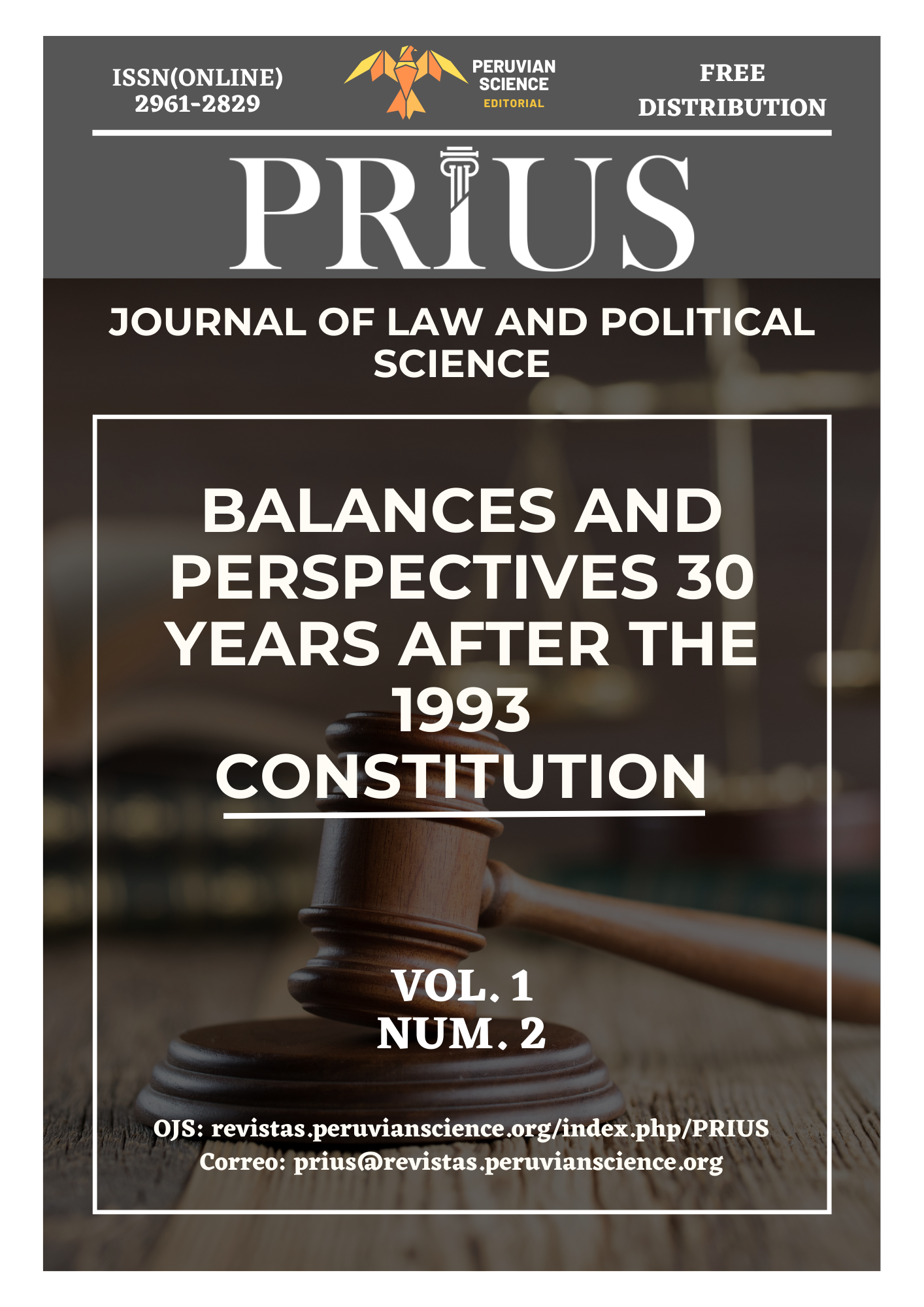The 1993 Constitution: The limit to state intervention in the Peruvian economy
DOI:
https://doi.org/10.5281/zenodo.11187361Keywords:
Constitution of 1993, state intervention, peruvian economy, free competition, economic policyAbstract
The 1993 Constitution: the limit to state intervention. This article examines the role and limitations of state intervention in the Peruvian economy under the 1993 Constitution. The paper focuses on how this Constitution has delineated state participation in the economy, in contrast to the 1979 Constitution, emphasizing the principles of free competition and market freedom. An analytical approach is used to examine both theory and practical cases of state intervention, including price control and intervention in basic services. A review of state actions during the COVID-19 pandemic is a crucial aspect of the paper, highlighting the challenges faced in implementing draft legislation. The conclusions indicate that the 1993 Constitution establishes a balance between a free market and a certain degree of state intervention, necessary in specific situations to guarantee social and economic welfare. The importance of adhering to the Constitution in the formulation of economic policies, respecting the limits established for state intervention for economic welfare in the Peruvian economy, is highlighted.
Downloads
References
Álvarez Miranda, Ernesto, “El Modelo Económico De La Constitución Peruana”, IUS ET VERITAS 24, n.° 48 (2014): 256-69, https://revistas.pucp.edu.pe/index.php/iusetveritas/article/view/11921.
Blume Fortini, Ernesto, “La Constitución Económica Peruana Y El Derecho De La Competencia”, THEMIS Revista De Derecho, n.º 36 (1997): 29-37, https://revistas.pucp.edu.pe/index.php/themis/article/view/11717.
Chanamé Orbe, Raúl, “Constitución Económica”, Derecho y Sociedad, n.° 40 (2013): 43- 63, https://revistas.pucp.edu.pe/index.php/derechoysociedad/article/view/12788
Calderón, Andrés, Verdades y mitos de la constitución económica de 1993 (Lima: Penguin Random House Grupo Editorial, 2023).
CEPLAN. 2021. Nivel de ingresos y gastos en el Perú y el impacto de la COVID-19. Centro Nacional de Planeamiento Estratégico. https://geo.ceplan.gob.pe/uploads/2021_CEPLAN_Nivel_de_ingresos_y_gastos_en_el_Peru_y_el_impacto_de_la_COVID_19.pdf.
Ruiz Caro, Ariela . 2002 “El proceso de privatizaciones en Perú durante el periodo 1991- 2002."Instituto Latinoamericano y del Caribe de Planificación Económica y Social - ILPES. https://www.cepal.org/es/publicaciones/7273-proceso-privatizaciones-peru-durante-periodo-1991-2002.
Juan Rivadeneira Frisch, Economía social de mercado (Quito: Fundación Konrad Adenauer, 2009), acceso el 9 de noviembre de 2023, https://www.kas.de/c/document_library/get_file?uuid=0fa7d85d-101f-84f1-c646-027f7cea64f0&groupId=252038 .
Guzmán Napurí, Christian, “Algunos Comentarios Respecto De Los Principios Generales Del Régimen Económico Consagrado Por La Constitución Peruana De 1993”, Foro Jurídico n.º 03 (2004): 115-27, https://revistas.pucp.edu.pe/index.php/forojuridico/article/view/18344.
GOB.PE. 2021. “Precios de medicamentos recetados para COVID-19 fueron hasta 123,6% más caros en clínicas en comparación a farmacias privadas”. Acceso el 06 de noviembre. https://www.gob.pe/institucion/indecopi/noticias/524071-precios-de-medicamentos-recetados-para-covid-19-fueron-hasta-123-6-mas-caros-en-clinicas-en-comparacion-a-farmacias-privadas.
Instituto Peruano de Economía (IPE). 2010. "La aventura empresarial del Estado en la década de 1970." Columna de opinión. Acceso el 07 de noviembre. https://www.ipe.org.pe/portal/comentario-diario-05-5-2010-la-aventura-empresarial-del-estado-en-la-decada-de-1970/.
Instituto Peruano de Economía (IPE). "La Constitución de la Economía Peruana." Informe El Comercio. Acceso el 06 de noviembre. https://www.ipe.org.pe/portal/la-constitucion-de-la-economia-peruana/.
Daniel Macera, “Estado empresario: ¿Qué tan eficientes son en realidad las empresas públicas?”, El Comercio Perú, 8 de junio del 2019, acceso el 9 de noviembre del 2023 https://elcomercio.pe/economia/peru/empresario-eficientes-son-realidad-empresas-publicas-noticia-642947-noticia/ .
Instituto Peruano de Economía (IPE). 2021. “Control de precios, ¿remedio o enfermedad?. Boletín IPE. Acceso el 07 de noviembre. https://www.ipe.org.pe/portal/wp-content/uploads/2021/03/Boletin-control-de-precios_v1.pdf.
Francisco Floríndez, Sebastián Velarde y Laura Zúñiga, “¿CÁRCEL PARA LOS COLUSORES? REFLEXIONES SOBRE LA CRIMINALIZACIÓN DE LAS PRÁCTICAS ANTICOMPETITIVAS EN EL PERÚ", THEMIS, n.°78 (2020): 207-217. https://revistas.pucp.edu.pe/index.php/themis/article/view/24173/22936
Marcelo Osman Mancisidor García, “La economía social de mercado como modelo ideal? Análisis y proyección constitucional en el Perú", Boletín de Sociedades, 5 de septiembre del 2022, acceso el 9 de noviembre del 2023, https://boletinsociedades.com/2022/09/05/la-economia-social-de-mercado-como-modelo-ideal-analisis-y-proyeccion-constitucional-en-el-peru/.
“Impacto del Intervencionismo: Pérdida de Productividad, Capital e Ingresos”, Asociación IPAE, acceso el 9 de noviembre del 2023, https://www.ipae.pe/propuestas-ipae-en-desarrollo-nacional/impacto-del-intervencionismo-perdida-de-productividad-capital-e-ingresos/.
Álvarez Miranda, Ernesto, “El Modelo Económico De La Constitución Peruana", IUS ET VERITAS 24, n.°48 (20114): 256-69. https://revistas.pucp.edu.pe/index.php/iusetveritas/article/view/11921.
Portocarrero, Gonzalo, “Sobre La Intervención Del Estado En La Economía”, Debates En Sociología, n.º 3 (1978): 77-90, https://doi.org/10.18800/debatesensociologia.197802.004 .
Quispe Correa, Alfredo, "Principios económicos de la constitución", Cultura 20, no. 1 (2006): 505-517, https://www.revistacultura.com.pe/revistas/RCU_20_1_principios-economicos-de-la-constitucion.pdf.
Published
How to Cite
Issue
Section
License
Copyright (c) 2023 PRIUS - Journal of Law and Political Science

This work is licensed under a Creative Commons Attribution-NonCommercial-NoDerivatives 4.0 International License.
PRIUS applies the Creative Commons Attribution (CC BY) license to the articles and other works we publish. Therefore, each manuscript submitted for publication by the journal will be processed under the CC BY license. The use of this license is consistent with the open access policy of the journal, since this is the most open license considered "the gold standard" of open access. The summary of this license can be reviewed at: https://creativecommons.org/licenses/by/4.0/
















